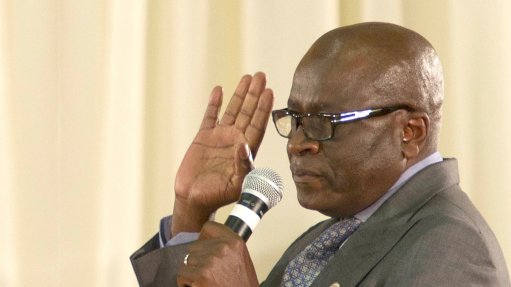
Ngoako Ramatlhodi
Photo by: Duane Daws
JOHANNESBURG (miningweekly.com) – South Africa’s Mineral Resources Minister Ngoako Ramatlhodi will on Tuesday brief the media on the outcomes of the audit to assess the extent to which mining companies have complied with the Mining Charter in the ten years to 2014.
This follows the Minister making it clear last month that the Department of Mineral Resources (DMR) audit of charter compliance would be released before the end of March after the DMR commissioned auditing firm Moloto Solutions to conduct the audit in July 2014.
A top priority on the charter’s transformation list is that historically disadvantaged South Africans have 26% ownership of mining companies.
It also places significant emphasis on compliance with employment, social, community and labour obligations.
Ramatlhodi has repeatedly stated that his department would not compromise its compliance expectations and emphasised that steps would be taken against companies that failed to comply with the charter after the audit had been completed.
The charter, adopted in 2004 and given a revised scorecard in 2010 to sharpen its efficacy in driving transformation and competitiveness in the mining sector, attaches conditions with which the holders of mining rights must comply with the Mineral and Petroleum Resources Development Act.
Earlier this month, major gold mining companies outlined to the media the strides that they had taken in implementing the charter, with AngloGold Ashanti, Gold Fields, Harmony Gold and Sibanye Gold reporting collective expenditures of R1-billion-plus on housing and accommodation for their workers, with many hostels having been upgraded and converted into single accommodation units.
AngloGold Ashanti reported that it had spent R349-million since 2005 to ensure it met the charter’s 2014 target of single accommodation at its hostels, with the company now having six complexes of multistorey buildings housing 8 817 employees in single quarters.
It had also converted 100% of residences, which were previously classified as redundant, into family units housing 4 916 employees.
More than 11 200 AngloGold employees were receiving living-out allowances (LOAs).
Gold Fields said that it had spent R74-million on its hostel upgrading programme at its South Deep mine during 2013 and 2014, with the mine now housing 845 workers in single room quarters. Another 1 148 workers were staying in family accommodation and just over 1 000 were recipients of LOAs.
Harmony reported an expenditure of R224.5-million on housing and accommodation for its employees in 2014, and R440-million since 2005 to meet the 2014 charter target to create 8 500 single quarter units and 1 825 family accommodation units. Another 16 565 employees were receiving a LOA at a cost of R367-million.
Sibanye Gold reported that it had spent R608-million since 2006 on building new accommodation and that the company had 12 281 single quarter dwellings and 6 740 family units with some 14 400 employees receiving LOAs.